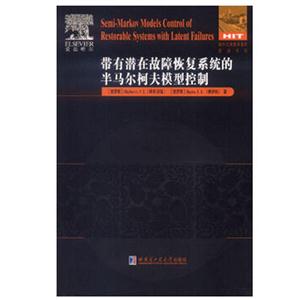带有潜在故障恢复系统的半马尔柯夫模型控制
本书特色
[
《带有潜在故障恢复系统的半马尔柯夫模型控制(英文)》涵盖了半马尔柯夫模形在单组分系统里不同的控制策略,定义了它们的可靠性和有效性的平稳特征,并且利用了由V.S.Korolyuk和A.F.Turbin自主开发的渐近阶段扩大的方法。其次,探索了半马尔科夫模形在双组分系统中的潜在失败控制。*后,给出了不同函数系统的半马尔柯夫模型。
]
内容简介
[
《带有潜在故障恢复系统的半马尔柯夫模型控制(英文)》由哈尔滨工业大学出版社出版。
]
作者简介
[
作者:(俄罗斯)阿布泽瑞(Obzherin Y.E.) (俄罗斯)博伊科(Boyko E.G.)
]
目录
目录
Preface List of Notations and Abbreviations Introduction 1.Preliminaries 1.1 Strategies and Characteristics of Technical Control 1.2 Preliminaries on Renewal Theory 1.3 Preliminaries on Semi—Markov Processes with Arbitrary Phase Space of States 2.Semi—Markov Models of One—Component Systems with Regard to Control of Latent Failures 2.1 The System Modelwith Component Deactivation while Control Execution 2.1.1 The System Description 2.1.2 Semi—Markov Model Building 2.1.3 Definition of EMC Stationary Distribution 2.1.4 Stationary Characteristics Definition 2.2 The System Modelwithout Component Deactivation while Control Execution 2.2.1 The System Description 2.2.2 Semi—Markov Model Building 2.2.3 Definition of EMC Stationary Distribution 2.2.4 Stationary Characteristics Definition 2.3 Approximation of Stationary Characteristics of One—Component System without Component Deactivation 2.3.1 System Description 2.3.2 Semi—Markov Model Building of the Supporting System 2.3.3 Definition of EMC Stationary Distribution for Supporting System 2.3.4 Approximation of the System Stationary Characteristics 2.4 The System Model with Component Deactivation and Possibility of Control Errors 2.4.1 System Description 2.4.2 Semi—Markov Model Building 2.4.3 Definition of EMC Stationary Distribution 2.4.4 System Stationary Characteristics Definition 2.5 The System Model with Component Deactivation and Preventive Restoration 2.5.1 System Description 2.5.2 Semi—Markov Model Building 2.5.3 Definition of the EMC Stationary Distribution 2.5.4 Definition of the System Stationary Characteristics 3.Semi—Markov Models of Two—Component Systems with Regard to Control of Latent Failures 3.1 The Model of Two—Component Serial System with Immediate Control and Restoration 3.1.1 System Description 3.1.2 Semi—Markov Model Building 3.1.3 Definition of EMC Stationary Distribution 3.1.4 Stationary Characteristics Definition 3.2 The Model of Two—Component Parallel System with Immediate Control and Restoration 3.2.1 System Description 3.2.2 Definition of System Stationary Characteristics 3.3 The Model of Two—Component Serial System with Components Deactivation While Control Execution, the Distribution of Components Operating TF is Exponential 3.3.1 System Description 3.3.2 Semi—Markov Model Building 3.3.3 Definition of EMC Stationary Distribution 3.3.4 Stationary Characteristics Definition 3.4 The Model of Two—Component Parallel System with Components Deactivation While Control Execution, the Distribution of Components Operating TF is Exponential 3.4.1 Definition of EMC Stationary Distribution 3.5 Approximation of Stationary Characteristics of Two—Component Serial Systems with Components Deactivation While Control Execution 3.5.1 System Description 3.5.2 Semi—Markov Model Building of the Initial System 3.5.3 Approximation of the Initial Stationary Characteristics 4.Optimization of Execution Periodicity of Latent Failures Control 4.1 Definition of Optimal Control Periodicity for One—Component Systems 4.1.1 Control Periodicity Optimization for One—Component System with Component Deactivation 4.1.2 Optimal Control Periodicity for One—Component System Without Deactivation 4.1.3 Control Periodicity Optimization for One—Component System with Regard to Component Deactivation and Control Failures 4.2 Definition of Optimal Control Periodicity for Two—Component Systems 4.2.1 Control Periodicity Optimization for Two—Component Serial System 4.2.2 Control Periodicity Optimization for Two—Component Parallel System 5.Application and Verification of the Results 5.1 Simulation Models of Systems with Regard to Latent Failures Control 5.1.1 Comparison of Semi Markov with Simulation Model in Case of One—Component System 5.1.2 Comparison of Semi—Markov with Simulation Model in Case of Two—Component System 5.2 The Structure of the Automatic Decision System for the Management of Periodicity of Latent Failures Control 5.2.1 Description of ADS CPM of Latent Failures Operation 5.2.2 Passive Industrial Experiment 6.Semi—Markov Models of Systems of Different Function 6.1 Semi—Markov Model of a Queuing System with Losses 6.1.1 System Description 6.1.2 Semi—Markov Model Building 6.1.3 EMC Stationary Distribution Determination 6.1.4 System Stationary Characteristics Determination 6.2 The System with Cumulative Reserve of Time 6.2.1 System Description 6.2.2 Semi—Markov Model Building 6.2.3 System Characteristics Determination 6.3 Two—phase System with a Intermediate Buffer 6.3.1 System Description 6.3.2 Semi Markov Model Building 6.3.3 System Stationary Characteristics Approximation 6.4 The Model of Technological Cell with Nondepreciatory Failures 6.4.1 System Description 6.4.2 TC Semi—Markov Model Building 6.4.3 TC Characteristics Determination Appendix A The Solution of the System of Integral Equations (2.24) Appendix B The Solution of the System of Integral Equations (2.74) Appendix C The Solution of the System of Integral Equation (3.6) Appendix D The Solution of the System of Equation (3.34) References Index
封面

书名:带有潜在故障恢复系统的半马尔柯夫模型控制
作者:阿布泽瑞
页数:199
定价:¥98.0
出版社:哈尔滨工业大学出版社
出版日期:2016-01-01
ISBN:9787560357607
PDF电子书大小:58MB 高清扫描完整版
